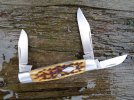*mounts soapbox*
All I've learned is that generally it's unsatisfactory to try and peg down traditional knife patterns with a title.
The lens you view it through always impacts the kind of definition you want.
I usually want a modern interpretation of the history.
In other words- if I was buying the knife sight unseen, would I know what to expect when it arrives?
Would I guess the handle shape, blade configuration, or general size? What was the archetypal historical version of the pattern?
Others are more interested in the historical view, which relies on a lot of information, including marketing, to place the knife in some kind of context.
This recognizes that patterns change over time and that, to pick one example as the pattern archetype, is to ignore other examples that may be valid.
Stockman? Cattle knife? I bet I could find branded versions of both that are nearly interchangeable.
*dismounts soapbox*

